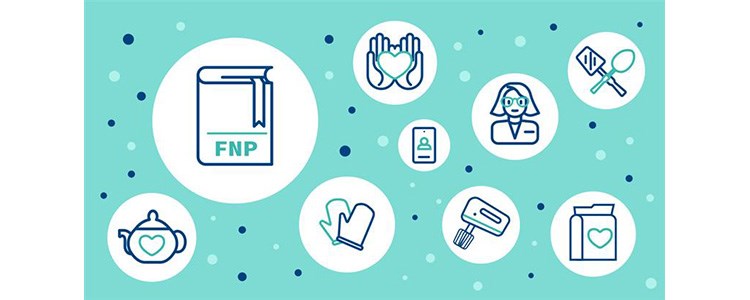Getting the recipe right for blended learning in Family Nurse Partnership

Getting the recipe right for blended learning in Family Nurse Partnership
COVID-19 brought with it a range of challenges, not least disrupting our day to day lives, causing stress and distress for many. Yet, it also gave us an opportunity to stop, reflect and consider the what, why and how of our lives both personal and professional.
Meeting a friend for lunch or catching up with a colleague in the kitchen has so much more significance now and looking back on those moments, you realise we took it a little for granted.
Our routines and lives have changed, so too has the speed at which we have innovated and developed.
The same is true for the Family Nurse Partnership (FNP); which is, by its nature an iterative programme. COVID-19 has been the stimulus to develop our education programme using blended learning.
This didn’t mean we threw everything into the mix, hit the button and hoped we hadn’t added too much celery or spinach, (yes I speak from experience!). We had to stop, take stock and consider how we could continue to offer high quality FNP education while remaining true to the licence and recognising what was happening in the Boards. This involved intentional and thoughtful review of what we could do.
The FNP education team deliver an education programme rather than individual courses and often have 5 cohorts running simultaneously. This creates its own challenges. What follows is some of our learning as we transitioned our education programme and the learning is ongoing.
So here is our recipe…Bake Off eat your heart out (heart shaped cake, obviously!)
Ingredients
1 education team (ready and willing to give it a go)
5 cohorts of Family Nurses and Supervisors (also ready and willing to give it a go)
1 utterly amazing and unflappable business support colleague (who also happens to be great IT tech support)
1 supportive manager (who trusts we can deliver)
1 national leadership team (who know we will provide what is needed when it is needed)
Equipment
Working IT Hardware
The most recent version of Teams (tricky one this!)
Headset (never underestimate the power of a headset!)
Method
1. Weigh up the balance of a live or pre-recorded approach, or a mixture of both. We decided to use a mixture depending on the needs of the nurses and where they were in the learning journey.
2. Slice and dice your learning content and adapt it for the online environment. Don’t assume the Powerpoint you have delivered many times will translate. Consider how you can ensure an interaction every 5-7 seconds (yes really!) To do this engage with your learners through chat, raised hand, facilitated discussion, Whiteboard, Jamboard, your chopping board… just keep the interaction moving.
As our confidence has grown, we have started to develop and use some specific tools to enhance learning including films, quizzes, interactive slides, interactive activities. Some aspects of FNP education include clinical skill simulation and need to be delivered face-to-face in a classroom setting and these had to be considered carefully and delivered with smaller cohorts in a Covid secure venue (NES offices).
3. Stir in enthusiasm and patience. Establish a friendly and inviting online space using your enthusiasm for the subject. This keeps learners engaged and motivated. Add in any additional materials you can that demonstrate your enthusiasm for the topic to add richness and depth. If you’ve recently read an article or watched a TED talk that links to the topic, share it! Patience will be required for IT, your WIFI connection, your learners and yourself! Don’t expect to be able to do everything immediately. We quickly learned to avoid a style over substance trap. While it may be tempting to use every new tool or app Teams has to offer, focus on the substance, the topic and the learning outcomes
4. Whisk in involvement and collaboration of your learners. Be clear about what is expected from them particularly in relation to preparation for any session. We did this by offering “orientation to online learning” sessions which enabled everyone to get familiar with the technology. We now also allocate a “link” educator to small groups of learners. This educator meets with their small group prior to and throughout the course. This supports the feeling of a more personal touch. We have also encouraged learners, where possible, to create a study space and we’ve sent materials to support this. We also invited all learners to have something in their study space to remind them of the baby.
5. Flip the learning: where possible invite learners to take part in some “flipped classroom” activities - where learners are given some reading or reviewing to complete in advance to support contribution to a live Q&A or facilitated discussion. We have used this method and have been delighted with the engagement and learning it has supported. This helps move the educator from “sage on the stage” to “guide on the side”. Who knew we could become a side order!
6. Taste, season, sprinkle, enjoy! Remember to taste your learning through ongoing evaluation. We gather informal feedback after every session and then more formal feedback. We have learnt so much for this and have adapted and adjusted our online learning in response to the feedback received.
This is an ongoing process… Sprinkle on your magic…learning makes people feel more confident and empowered, share it out and have FUN!
Lesley O'Donnell, Principal Educator (FNP)
November, 18 2020
